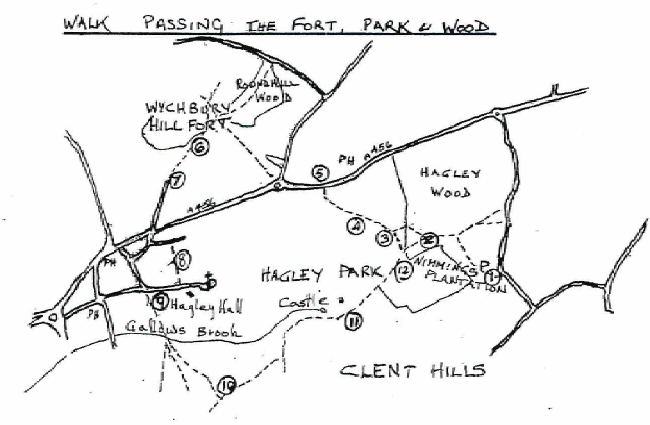WALKS AROUND HAGLEY: WALK No.9 WYCHBURY
DISTANCE 4 MILES TIME: ABOUT TWO & HALF HOURS PARK IN NIMMINGS WOOD NT CAR PARK (O.S. MAP GRID REF. 937807 or one car may find space at roadside on quieter roads enroute.)
- Take the path down from the N.T. Centre towards Hagley Wood. Note the views over the Black Country to Rowley, Dudley and Brierley Hill. Turn left where the path joins the one from your right.
- In 200m. (220 yards) go over a stile into the wood. The field behind you was carved out of Hagley Wood in medieval times. The revised ditch & bank boundary can be seen if you look carefully. This arrangement was intended to keep animals out of the wood.

- Through the wood join the surfaced track and turn left. In about 100m. (110 yards) on your right you will see a deer leap. During World War II the deer were let out of the Park because no feed was available for them in winter but they were encouraged to come back after the War ended by putting in this deer leap.
- Turn back and head towards the A456. As you near Hagley Hill Farm take the path on the right to get to the main road. The farm site suggests an early date but no documentary proof. This was a working farm, part of Hagley Hall Estate, but farmed by tenants until the 1990's when the barns were converted and sold as housing. At this time the footpath, which formerly went through the farmyard, was diverted.
- Cross the road carefully. Turn left and then right into Wassell Grove Lane. Cross the Lane and take the path to Wychbury Hill Fort. On your left is the Obelisk (known locally as Hagley Monument). Look out for an old track that crosses the path from Hagley towards Cradley - notice the dip in the far hedge (which indicates where it was). As you climb the hill feel, if not see, the ridge and furrow (results of ploughing methods many centuries ago) - the ground rises and falls a matter of a few inches as you walk. At the stile look at the steep slope to your left giving natural protection to the Iron Age Fort on this side.

- Retrace your steps and follow the path down between the Monument and the Fort. The Monument was built by Admiral Thomas Smith (Lord Lyttelton's illegitimate half brother who lived at Rockingham Hall) in the eighteenth century as an "eye-catcher". He also employed James "Athenian" Stuart to design and build the "Temple of Theseus" which is the earliest Greek Revival building in Europe (1758). This is lower down the slope and can be seen from the A456. Take a look through the hedge to your right and you may catch a glimpse of the massive banks and ditches giving protection to this side of the Hill Fort.
- The path leads down to Monument Lane. On the main road to your left, behind the hedge is Rockingham Hall. Its origins date from about 1600 but Admiral Smith employed Sanderson Miller to extend the house in 1751. It was also altered and extended in Victorian times, and is now divided into flats. The detached building, on the left hand side between you and the hall was the Orangery and it is now two houses. Cross the A456 and go into School Lane.
- Turn left into Hall Meadow and then right on to the path across to Hagley Hall. The mews on your right were built at the same time as the Hall. Sir George, later Lord Lyttelton, built the Hall from 1756-60 in the fashionable Palladian style by Sanderson Miller. The cricket pitch is the site of the old Elizabethan Manor House which was pulled down at the same time that the Hall was built. Turn right into Hall Drive and by the lodge turn left on to the path. Note the drinking fountain on the wall
- The path leads to the Sunfield Homes, a home and school for mentally handicapped children. As you go down the slope note the hollow way on the left. This would have been the original track over Gallows Brook and on to Clent.
- Turn left on the track that takes you onto the. Clent Hills, and then left again to follow the boundary path between the Clent Hills and Hagley Park. The Park was originally a medieval deer park. It has been owned by the Lyttelton family since 1564. In 1747 improvements were begun to make it "Modern" by building various features or follies as ornamentation. It is over 200 acres and much of it is still used for farming deer.

- In the Park by the gates the Gothic Castle can be seen, completed in 1748. This castle was built by Sanderson Miller and he is known to have used some masonry from Halesowen Abbey. It was admired by Horace Walpole when he visited Hagley Hall. It is one of several 18th century follies in the grounds. Continue to follow the Park boundary fence until it turns to the left. Go forward over the stile for about 200m. (220 yards) to the point where you turned into Hagley Wood.
- From here retrace the route back and uphill to Nimmings Wood car park, or carry on if you started the walk at one of the other points.
 1
1
